The impact of late 19th century Japanese aesthetics on western art in general and the Impressionists in particular has been well documented. After viewing the “Colin Goldberg: Techspressionism” exhibition at Glenn Horowitz Bookseller in East Hampton, I was reminded of how much less attention has been paid to the influence of Japanese sensibilities on the evolution of surrealism, abstract expressionism and other non-objective approaches in the west since the early years of the 20th century.
Reacting against the rigid Western principle that reality in the corporeal universe is based solely on reason and actual physical structure, many of the surrealists and, later, the action painters, looked to Zen notions of reality as a more mysterious realm of interpretational illusion, filled with images more felt than seen.
As the ethnomusicologist Fredric Lieberman noted in his essay “Zen Buddhism and Its Relationship to Elements of Eastern and Western Art,” non-objective artists were drawn to Zen principles based on the idea that “Oriental art depicts spirit, while Western art depicts form.” He went on to suggest that these artists came to believe the differences between the two could be reconciled.
This ongoing painterly juxtapositional marriage of form and feeling serves as the underlying theme in the “Techspressionism” exhibition, which was curated by Scott Bluedorn. The show highlights Goldberg’s joining of digital technology and gestural painting to create works that are both energetically rhythmic and elegantly choreographed.
Using the more painterly motifs as a ground, Goldberg superimposes digital imagery in a manner that allows the two to seamlessly interact, conjuring imaginary horizons amid swoops of color, light, or line that serve to orchestrate the cadences and modulated harmonies of the images themselves.
This kind of interaction is particularly notable in works such as Magnetic Resonance (acrylic with pigment on canvas, 2014), in which the superimposed imagery vibrates with an understated intensity while at the same time the artist’s confident use of negative space allows for the geometric elements to establish themselves assertively within the painting’s organizational framework.
.

"Magnetic Resonance" by Colin Goldberg, 2011. Acrylic with pigment on canvas, 32 x 20 inches.
.
In addition, Goldberg uses elegantly fragile linear components that bend as if being warped in some spatial anomaly. These elements impart a subtle yet persistent sense of perspective and distance that insistently draws the viewer’s gaze from the lower quadrant inward toward the center of the composition itself.
The same sensibilities are apparent in works such as Dynamic Dispatch (acrylic and spray enamel on canvas, 2011) and Wireframe Landscape #2 (laser etched marble, 2006).
.
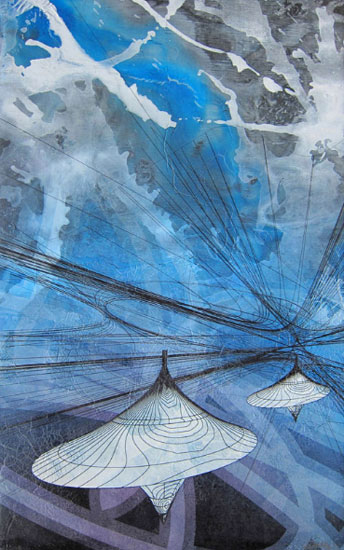
"Dynamic Dispatch" by Colin Goldberg, 2011. Acrylic with pigment on canvas, 32 x 20 inches.
.

"Wireframe Landscape #2" by Colin Goldberg, 2006. Laser etched marble mounted on wood panel, 12 x 24 x 2 inches.
.
In New Plastic Shoda #6, the artist uses a stylized calligraphic character that serves to simultaneously anchor the background portion of the picture plane while depth and a graceful rotational motion is provided by the geometric image that floats, seemingly effortlessly but with a certain dynamic persistence, in the work’s foreground.
.
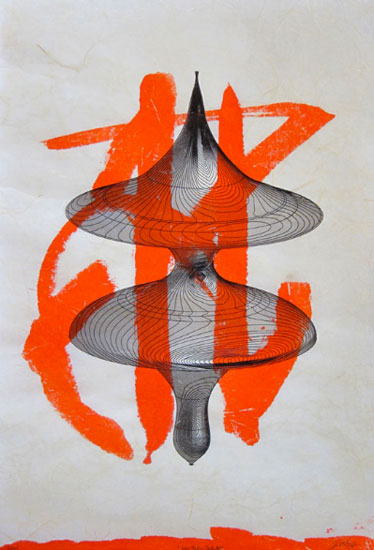
"New Plastic Shodo #6" by Colin Goldberg, 2013. Sumi ink, acrylic and pigment on Kinwashi paper, 18 x 12 inches.
.
Calligraphic elements and their emphasis on expressiveness and asymmetry have always been the most prevalent aspect of Asian art apparent in the work of abstract expressionists such as deKooning, Francis, Tobey and Kline. Goldberg goes further, at times drawing on stylistic motifs and use of color commonly associated with 18th and 19th century traditional Japanese wood-block printing.
In Iruka (pigment and acrylic on birch panels with liquid polymer, 2013), for example, the artist manipulates the digital elements so that they take on a configuration and sense of organic power that is strikingly similar to the effect of the ocean waves in Hokusai’s seminal print The Great Wave off Kanegawa from the series 36 Views of Mount Fuji. There’s a similar sensibility at work in Inazuma (acrylic and pigment with liquid polymer on birch panels, 2013) that seems, aside from the three-panel motif, to gently echo the compositional structure of a later work by Hokusai titled Kaijo no Fuji.
.
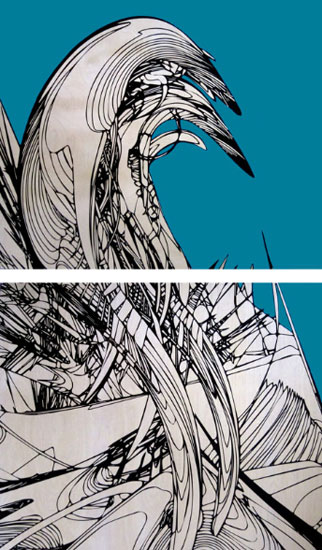
"Iruka" by Colin Goldberg, 2013. Acrylic and pigment with liquid polymer on birch panels, Diptych, 41 x 24 inches.
.
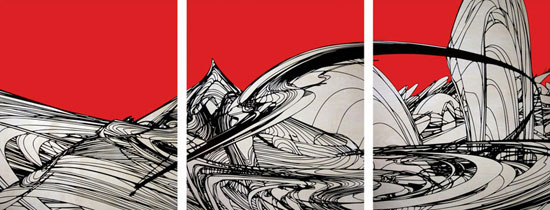
"Inazuma" by Colin Goldberg, 2013. Acrylic and pigment with liquid polymer on birch panels, triptych, 24 x 62 inches.
.
Further along these lines, the artist also channels the energy and intensity of contemporary Japanese graphic novels, known as “manga.” Examples can be seen in the series titled Variations (acrylic, pearlescent latex glaze and pigment on linen) as well as in some smaller pieces, like Itadaki (gouache and pigment transfer with liquid polymer on birch panel, 2014) and Kawa (acrylic and pigment with liquid polymer on birch panel, 2014).
.
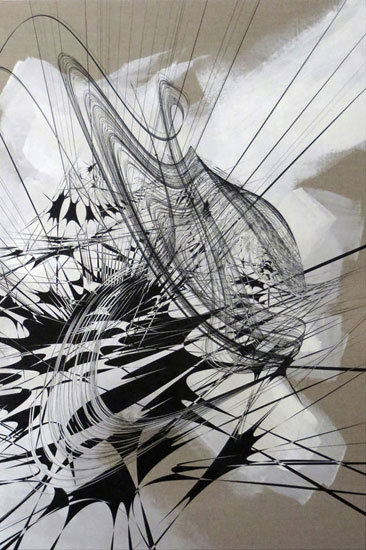
"623 Variation #3" by Colin Goldberg, 2014. Acrylic pigment and latex glaze on linen.
.
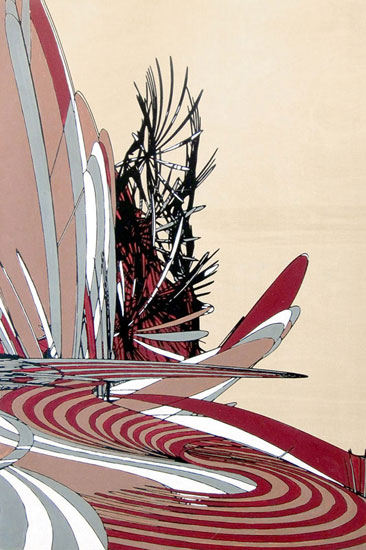
"Itadaki" by Colin Goldberg, 2013. Gouache and pigment transfer with liquid polymer on birch panel.
.
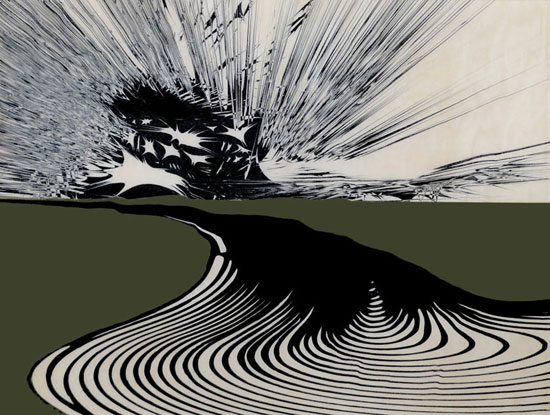
"Kawa" by Colin Goldberg, 2014. Acrylic and pigment with liquid polymer on birch panel.
.
BASIC FACTS: “Colin Goldberg: Techspressionism” was extended through November 20, 2014 at Glenn Horowitz Bookseller at 87 Newtown Lane, East Hampton, New York 11937. www.glennhorowitz.com/easthampton; www.techspressionism.com
_____________________________
Copyright 2014 Hamptons Art Hub LLC. All rights reserved.
